Kimberly M. Tarvis
Holograms are complicated. It’s as simple as that! A simple image that you see contains innumerable data points to be able to create an image that is not only life-like, but can be viewed at all angles with the same realistic appearance (Goodman & Lawrence, 1967). In this next section, we will answer the following questions to help uncover the secrets of how holographs work:
- How do holograms work?
- How is a holographic image created?
- What are the different types of holograms?
How do holograms work?
Kasper & Feller (2001) explain that the basic premise of a hologram includes two main physics tools: light and reflection of that light. A hologram is just a reflection of the light that you see imprinted from an image. That’s it. Yet, why are there entire branches of physics devoted to the theory of holography? How do holograms differ from regular photographs? The answer to this question is the main principle of a holograph: a holographic image is three-dimensional (3-D); a photograph is two-dimension (2-D) (Leseberg, 1992). Two-dimensional images are flat; they can only be seen horizonal axis dimension (X-axis) and vertical axis dimension (Y-axis). Three-dimensional images are not flat, but rather add a third dimension to the equation: the Z-axis, which is known as “depth” (Leseberg, 1992). This gives the viewer a chance to rotate the image and view it from multiple perspectives. You can see other parts of the 3-D image when doing this that you cannot see in a 2-D image. More complicated holograms allow for an almost complete 360 degree unobstructed view of an image, where the viewer can see everything! Beyond 3-D is just an experience for the cinema, and sometimes we often get caught up in what is 4-D, 5-D, 6-D, 7-D, 8-D, and 9-D (Owatch, 2022). These all have to with experiences beyond what you can see, with seats moving, areas around you rotating, interactivity with the features, sounds, smells, etc. (Owatch, 2022).
Benton & Bove (2008) describe physical holograms, ones that are made on a plate, work in two different ways for the image to be viewed: (1) light is reflected off of the hologram image to the viewer or (2) a laser is shown through the image to the viewer. The image is “stored” or printed on a physical piece of substance. The viewer’s eye works to pick up any light that is reflected or beamed through the image, and you are able to see the 3-D holographic image!
Below is a YouTube video from PBS Digital Studios/Physics Girl (2016) that discusses the process in further detail:
Only until recently in 2018 were holograms created to “sit” or appear in thin air (Smalley et al., 2022). Much of the other types of images rely on projectors, screens, and reflective lenses to project and reflect their images to appear as holograms (Nature Video, 2021). But these images are not true holograms! Types of holograms, including the newly created thin air holograms and security hologram images, are explored in a later section of this chapter.
How is a hologram created?
From the Physics Girl YouTube video above (2016), light plays the most important role in creating a true hologram. In order to make a hologram, an image must be captured on a flat surface first in order to be viewed. As described in the previous chapter, a coherent light source is needed to create the image. Using the technique developed by Leith and Upatnieks (1962), Off-Axis technique, these tools are needed to create the image:
- A continuous wave laser
- Optical devices to direct the laser beam, including:
- Lens
- Mirrors
- Beam splitter
- Film holder
- Isolation table where the image is made, also known as an exposure
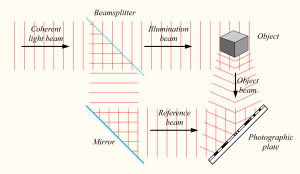
As Chuadhari et al. (2015) describe, a laser beam is split using a beam splitter to create two separate beams, (1) an illumination or object beam, and (2) a reference beam. The illumination or object beam shines on the object, and is refracted from the object to a photographic plate (exposure). The second beam, also known as the reference beam, is deflected by a mirror and is also shone on the photogenic plate. This creates an inference pattern that etches the surface of the photogenic plate. Since the two beams come to the plate in separate directions, the inference pattern is almost like a lattice, creating lines that can be seen when magnified under a microscope (Physics Girl, 2016).
To view the holographic image, known as reconstructing, where a reconstruction beam from a laser is shown on the photographic plate, and this is then reflected to the viewer, where the holographic image is seen (Stroke, 1966). Thus the virtual image can be viewed in 3-D!
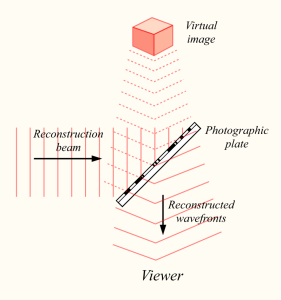
What are the different types of holograms?
There are many different types of holograms, and all differ in how they are created, viewed and used. Two types of holographic images can be found in circulation: true holograms and false holograms (Gordon, 2017). True holograms are created by a laser beam, while false holograms are created using other means, such as printing, etching, embossing and debossing. Beware of the false hologram! Below are the most common types of true and false holograms, along with an image and description of each type.
TRUE HOLOGRAMS
Four different types of true holograms exist, transmission, reflection, short pulse, and free-floating holograms (HoloCenter, 2022). Each has its own separate means of creation, along with how to view the image using either laser or white light. Depending on the circumstance for both the viewer and the producer, each type of true hologram has a specific use for the need of each. NOTE: free-floating holograms can be divided into free-floating particle holograms and free-floating solid light holograms (Light Field Labs, 2022; Smalley et al., 2018). Both types are recent advances in the field of holography, and each are explained in detail below.
Transmission Hologram:
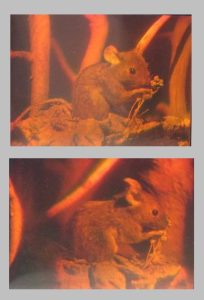
Using a laser beam in the reconstruction of a holographic image previously described in this chapter, the hologram can be viewed. This type of holographic image tends to be the most clear, sharpest, with added depth beyond the other types of holograms (HoloCenter, 2022). Transmission holograms produce a near perfect image!
Reflective Hologram:
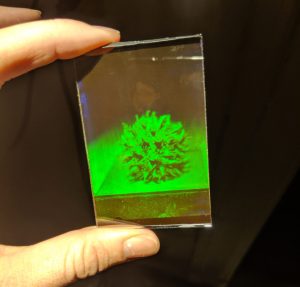
Although not described in the previous chapter, Russian researcher Yuri Denisyuk (1962) discovered a technique to create a holographic image on a photographic plate with a single laser beam, rather than two. As Denisyuk (1962) describes, the laser is shown through the specialized photographic plate, bounces off of the object on the other side, and is reflected back onto the plate to be recorded. The object’s reflection can then be viewed without the aid of a laser for reconstruction, but can use white light to reflect the image back to the viewer (Stroke, 1966).
Pulse Laser Hologram:
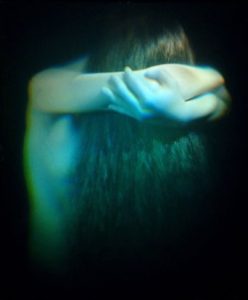
According to the HoloCenter for the Holographic Arts (2022), this type of hologram allows for image capture of live subjects! A pulse laser is used to emit short pulses, or flashes, of light that will “freeze” the image in motion.
Free-Floating Particle Hologram:
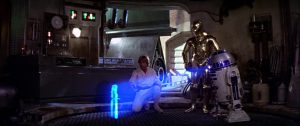
These are the types of holograms that researchers always dreamed about creating! If you have ever watched Star Wars (Lucas, 1977), R2D2 projected an image of Princess Leia speaking to Obi-Wan Kenobi. Her small image was projected into the still air without the use of a screen, the detail and realism made the princess almost life-like as she warned Obi-Wan Kenobi that he was her only hope for survival (Lucas, 1977). These types of holographic images, just standing in still air with only a light projected into the area, is the fantasy waiting to become reality.
In 2018, the holography research group at Brigham Young University, led by Dr. Dan Smalley, created the first true holographic image in still air without the use of projection! A laser was used to excite a particle in mid-air, and that particle was pushed around using the laser to create an image that can be seen as a non-flickering image by the naked eye. The image, about the size of a pencil eraser, was the first time an image did not need a supplementary screen to be reflected for viewing. Additional improvements have been made to the technology, when in 2021, can now produce animations that are much more complicated to create, on a much larger scale than before (Rogers & Smalley, 2021).
This YouTube video from Nature Video (2018) highlights Smalley’s research, including demonstration of the free-floating holograms produced in their laboratory after the 2018 Nature article was published:
Free-Floating Solid Light Hologram:
A recent advancement in true free-floating holographic technology has been reported by a Silicon Valley company, Light Field Laboratories, which has created a solid light holograph using a set of controls, sophisticated electronics, a photonic array and nanoparticles that are bounced across multiple surfaces (Light Field Lab, 2021). When working in unison, these parts create a free-floating image that is not only hyper-realistic, but can produce large images! Check out the YouTube video below from CNET (2021) that describes the technology, and demonstrates the future in holographic innovation.
FALSE HOLOGRAMS
These types of holograms are not technically holograms, even though we think of these as holographic images. Most of the false holograms that claim to be true holograms are made by means other than confluent light sources, e.g. lasers (Gordon, 2017). These holograms can have slight depth perception when viewed at certain angles, but lack the clarity and realism of true holograms created with laser light.
Printed False Holograms:
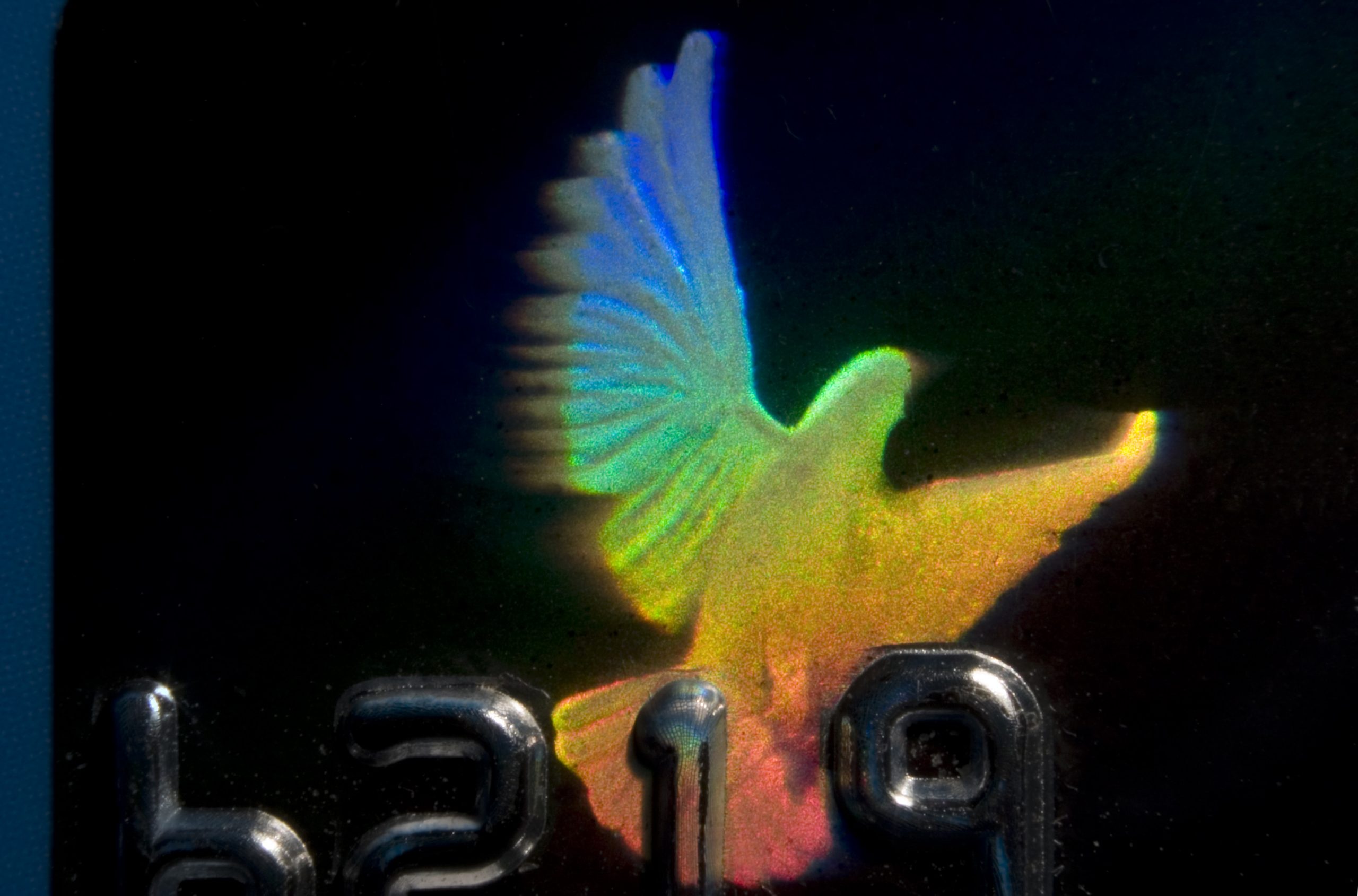
Additional types of holograms have been produced that allow for surface etching of plastics, with a thin layer of metal on top, that causes light to diffract light when it shines on the surface (Gordon, 2017). This causes an image to be seen, usually in different colors from the light spectrum. This is a prominent technique used on security seals for anti-tampering measures, since these metallic reflective holograms are extremely difficult to reproduce and can easily show signs of damage to the surface if the holographic image is no longer able to be viewed correctly (Miao et al., 2019).
Digital False Holograms:
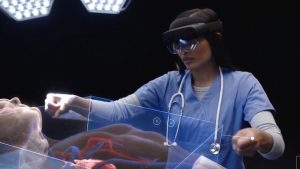
With technological advances in augmented reality (AR), the use of digital false holograms has been gaining traction in the past decade (Gordon, 2017). Kalantari & Rauschnabe (2017) explored the use of AR, finding this is especially true with the release of the Microsoft HoloLens and other AR devices. However, these images can cannot be viewed without their digital headsets, and they are often lacking in both realism and detail for image clarity. However, with further developments on the horizon in this area of digital hologram use in education, a wide range of industries, military, and personal use, digital false holograms will be viewed as true holograms in the near future.
References:
Benton, S. A., & Bove, V. M., Jr. (2008). Holographic imaging. Wiley.
Chaudhari, A., Lakhani, K., & Deulkar, K. (2015). Transforming the world using holograms. International Journal of Computer Applications, 130(1), 30-32.
CNET. (2021, October 7). REAL holograms are finally here! (And they look very cool) [Video]. YouTube. https://www.youtube.com/watch?v=7oGtgbsmmg8
Denisyuk, Y. N. (1962, December). Photographic reconstruction of the optical properties of an object in its own scattered radiation field [translated from Russian]. In Soviet Physics Doklady, 7(1962), 543.
Goodman, J. W., & Lawrence, R. W. (1967). Digital image formation from electronically detected holograms. Applied Physics Letters, 11(1967), 77-79. https://doi.org/10.1063/1.1755043
Gordon, M. (2017). Habitat 44 degrees [Master’s thesis, OCAD University]. ResearchGate. https://doi.org/10.13140/RG.2.2.30421.88802
HoloCenter for the Holographic Arts. (2022). Different Types of Holograms. HoloCenter. https://holocenter.org/what-is-holography/different-types-of-holograms
Kalantari, M., & Rauschnabel, P. (2018). Exploring the early adopters of augmented reality smart glasses: the case of Microsoft HoloLens. In T. Jung, & M. T. Dieck (Eds.), Augmented Reality and Virtual Reality. Progress in IS. (pp. 229-245) Springer. https://doi.org/10.1007/978-3-319-64027-3_16
Kasper, J. E., & Feller, S. A. (2001). The complete book of holograms: How they work and how to make them. Courier Corporation.
Lay, G-J. (2011). Two photographs of a single hologram taken from different viewpoints. Wikipedia. https://en.wikipedia.org/wiki/Holography#/media/File:Holomouse2.jpg
Leith, E. N., & Upatnieks, J. (1962). Reconstructed wavefronts and communication theory. Journal of the Optical Society of America, 52(10), 1123-1130. https://doi.org/10.1364/JOSA.52.001123
Leseburgh, D. (1992). Computer-generated three-dimensional image holograms. Applied Optics, 31(2), 223-229. https://doi.org/10.1364/AO.31.000223
Light Field Lab. (2021). Escape the screen. Light Field Lab. https://www.lightfieldlab.com/#tech
Lucas, G. (Director). (1977). Star Wars: Episode IV – A New Hope [film]. Lucas Films.
Maio, J., Ding, X., Zhou, S., & Gui, C. (2019). Fabrication of dynamic holograms on polymer surface by direct laser writing for high-security anti-counterfeit applications. Institute of Electrical and Electronic Engineers Access, 7(2019), 142926-142933. https://doi.org/10.1109/ACCESS.2019.2944838
Nature Video. (2018, January 24). Pictures in the air: 3D printing with light. YouTube. https://www.youtube.com/watch?v=YRZMdQOMPNQ
Nicholson, A.M. (n.d.). At the Gate [Pulse laser hologram]. HoloCenter for the Holographic Arts, New York, United States. https://holocenter.org/what-is-holography/different-types-of-holograms
Physics Girl. (2016). How 3D holograms work. YouTube. https://www.youtube.com/watch?v=0ics3RVSn9w
Owatch. (2022). What’s the difference between 4D, 5D, 6D, 7D, 8D, 9D cinema theater. https://www.stekiamusement.com/2018/whats-the-difference-between-4d-5d-6d-7d-8d-9d-cinema-theater-3465/
Rogers, W. & Smalley, D. (2021). Simulating virtual images in optical trap displays. Scientific Reports, 2021(11), 7522. https://doi.org/10.1038/s41598-021-86495-6
Smalley, D. E., Nygaard, E., Squire, K., Van Wagoner, J., Rasmussen, J., Gneiting, S., Qaderi, K., Goodsell, J., Rogers, W., Lindsey, M., Costner, K., Monk, A., Pearson, M. Haymore, B., & Peatross, J. (2018). A photophoretic-trap volumetric display. Nature, 553(7689), 486-490. https://doi.org/10.1038/nature25176
Stroke, G. W. (1966). White-light reconstruction of holographic images using transmission holograms recorded with conventionally-focused images and ‘in-line’ background. Physics Letters, 23(5), 325-327. https://doi.org/10.1016/0031-9163(66)90022-9
